891 Search Results for core vocabulary
September 7, 2016
by Carole Zangari -
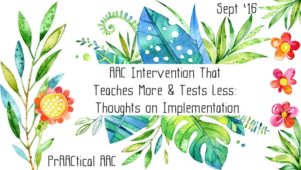
In an earlier post, I shared a graphic on the ways that AAC skills are ‘taught’ versus ‘caught.’ Teaching AAC skills involves the use of specific instructional strategies that give learners information and experiences which result in them being able to communicate more effectively. In many instances, we set out to do just that, but end up with an interaction that ‘catches’ what the student already knows how to do, rather than helping them gain additional skills. There are a few important concepts here. They both have an important role. ‘Catching’ skills isn’t bad. We can do this to figure out what the learner already knows/can do, and give him/her practice with the skill so that it becomes faster and easier to produce. When our interactions ‘catch’ a skill, we’ve created (or taken advantage of) an opportunity for communication. That’s important BUT, it isn’t teaching them anything new. Our learners do... [Read More...]
September 4, 2016
by Carole Zangari -

Here are a handful of AAC posts that may be of interest. Monday – PrAACtically September: Resources for a Year of Core Vocabulary Wednesday – AAC Assessment Corner with Vicki Clarke: AAC Skills Assessment for Direct Selectors Thursday – PrAACtical Supports for AAC Learners: AT Recipes for Success – Sensorimotor Activities
September 1, 2016
by Carole Zangari -
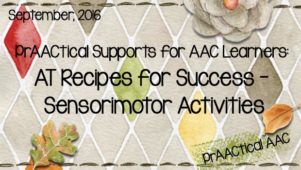
It’s time to resume our PrAACtical Supports series, highlighting handout materials developed by Sara Barnhill and the AT team at the Children’s Hospital of Richmond at VCU (CHoR). Sara is an SLP who has has worked at CHoR for six+ years. She is a member of the Assistive Technology Core team and VCU’s Center for Craniofacial Care team. Her caseload includes patients in clinics, outpatient therapy, and on the Transitional Care Unit which provides pediatric long-term care. The CHoR AT Program is one of few comprehensive AT programs in Central Virginia, providing AT evaluations, equipment and training to people of all ages, enabling children and adults with disabilities to function more independently. CHoR’s AT team consists of 4 SLPs, 2 OTs, a PT, and a Therapy Practice Assistant. In addition to completing transdiciplinary evaluations and treatments, CHoR’s AT team is responsible for supporting staff and sharing AT information to five CHoR therapy centers... [Read More...]
August 18, 2016
by Carole Zangari -
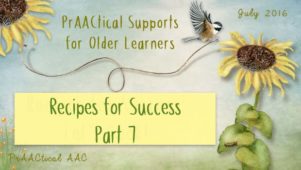
Welcome back to the PrAACtical Supports series, highlighting the work of the AT team at the Children’s Hospital of Richmond at VCU (CHoR). Meghan Reitz, an SLP who has worked at CHoR for over 3 years, returns to share activity ideas for older learners and downloadable handouts for their caregivers. She received her Master’s in SLP from the University of Virginia., which provides comprehensive services for pediatric healthcare. The CHoR AT Program is one of few comprehensive AT programs in Central Virginia, providing AT evaluations, equipment and training to people of all ages, enabling children and adults with disabilities to function more independently. CHoR’s AT team consists of 4 SLPs, 2 OTs, a PT, and a Therapy Practice Assistant. In addition to completing transdiciplinary evaluations and treatments, CHoR’s AT team is responsible for supporting staff and sharing AT information to five CHoR therapy centers throughout Central Virginia. Meghan has a passion for working... [Read More...]
August 11, 2016
by Carole Zangari -
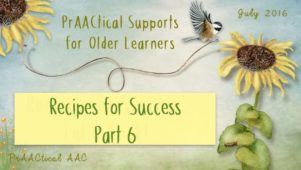
Welcome back to the PrAACtical Supports series, highlighting the work of the AT team at the Children’s Hospital of Richmond at VCU (CHoR). Meghan Reitz, an SLP who has worked at CHoR for over 3 years, returns to share activity ideas for older learners and downloadable handouts for their caregivers. She received her Master’s in SLP from the University of Virginia., which provides comprehensive services for pediatric healthcare. The CHoR AT Program is one of few comprehensive AT programs in Central Virginia, providing AT evaluations, equipment and training to people of all ages, enabling children and adults with disabilities to function more independently. CHoR’s AT team consists of 4 SLPs, 2 OTs, a PT, and a Therapy Practice Assistant. In addition to completing transdiciplinary evaluations and treatments, CHoR’s AT team is responsible for supporting staff and sharing AT information to five CHoR therapy centers throughout Central Virginia. Meghan has a passion for working... [Read More...]
August 8, 2016
by Carole Zangari -
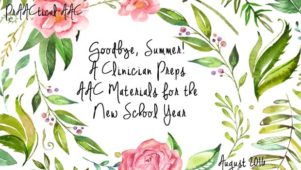
Here in the US, many SLPs who work in educational settings are getting ready to head back to school. In today’s post, we hear from Elizabeth Levy, an SLP at Wasatch County School District in Utah. Elizabeth, who earned her Bachelors and Master’s degrees from Towson University in Maryland, worked in early intervention for several years before joining the team at Midway Elementary two years ago. She has always had a passion for working with children who are nonverbal and require AAC, and is a member of ASHA’s Special Interest Group 12 (AAC). She also serves as part of her district’s AT team. In this post, Elizabeth shares a little bit about how she used the summer to gear up for an initiative to provide additional AAC support for students with significant learning challenges. ::::::::::::::::::::::::::::::::::::::::::::::::::::::::::::::::::::::::::::::::::::: This year, with a new team, I have a great opportunity to go big and... [Read More...]
August 3, 2016
by Carole Zangari -
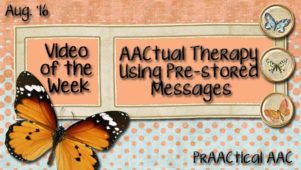
In the past few years, we’ve written a lot about the value of AAC systems that are rich in single core vocabulary words. Our position has always been, however, that many users of AAC will also benefit from fringe vocabulary words and selected prestored messages. You can read more about that here. To be sure, pre-stored messages, including phrases, sentences, and full questions, have their drawbacks. The main downside relates to the lack of flexibility they offer. Once programmed into a device, the communicator has to use them just the way they are. If he/she wants to say a variation of that message, they are out of luck. In the context of a robust system, however, this isn’t as problematic as it sounds. Individuals who have been provided with robust AAC systems can go to their single word vocabulary to be more precise if the pre-stored message doesn’t capture exactly... [Read More...]
July 31, 2016
by Carole Zangari -
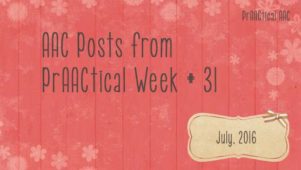
Hope to see some of our prAACtical friends at the 2016 ISAAC Biennial Conference starting August 6th. If you’re headed to Toronto, let’s connect for some prAACtical conversations! Monday – PrAACtically August: Resources for A Year of Core Vocabulary Words Tuesday – AAC Core Word Calendars for August Wednesday – AAC Assessment Corner with Vicki Clarke: Standardized Tests for AAC Users Thursday – PrAACtical Supports for Young AAC Learners: Recipes for Success, Part 4
July 28, 2016
by Carole Zangari -
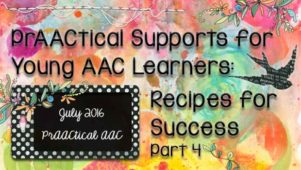
Thanks to all of you who have reached out with appreciation for Sara Barnhill’s guest series entitled PrAACtical Supports for the Young AAC Learner. Sara and her colleagues at Children’s Hospital of Richmond at VCU (CHoR) are generously sharing some of the resources they created to help families implement AAC at home. Through CHoR’s AT Program, one of few comprehensive AT programs in Central Virginia, a series of parent-friendly handouts were created to help families in Central Virginia facilitate core vocabulary learning by their young children. In the final post, we get to play with dolls and beach balls. You can get the link to download these parent handouts at the end of the post. ::::::::::::::::::::::::::::::::::::::::::::::::::::::::::::::::::::::::::::: Let’s Play with Core! Recipes for Success Abandonment of AAC systems is a recognized problem in the field of AT. Therapists, teachers, and caregivers alike often feel uncomfortable and intimidated by AAC. We can all acknowledge that “it takes a village,” but... [Read More...]
July 21, 2016
by Carole Zangari -
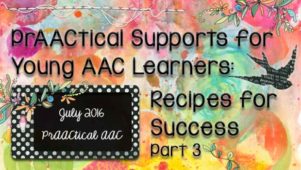
Looking for resources so you can help families get comfortable with implementing AAC at home? SLP Sara Barnhill has you covered! In the third installment of the PrAACtical Supports for the Young AAC Learner, she generously shares some parent handouts created along with her colleagues at Children’s Hospital of Richmond at VCU (CHoR). As a member of the Assistive Technology (AT) Core team, she is involved in AAC evaluations and therapy in the hospital’s clinics, out-patient program and Transitional Care Unit. CHoR’s AT Program is one of few comprehensive AT programs in Central Virginia. The program provides AT evaluations, equipment and training to people of all ages, enabling children and adults with disabilities to function more independently. CHoR’s AT team consists of four SLPs, two OTs, one PT, and one Therapy Practice Assistant. In addition to completing transdiciplinary evaluations and treatments, CHoR’s AT team is responsible for supporting staff and sharing AT information to five CHoR... [Read More...]









